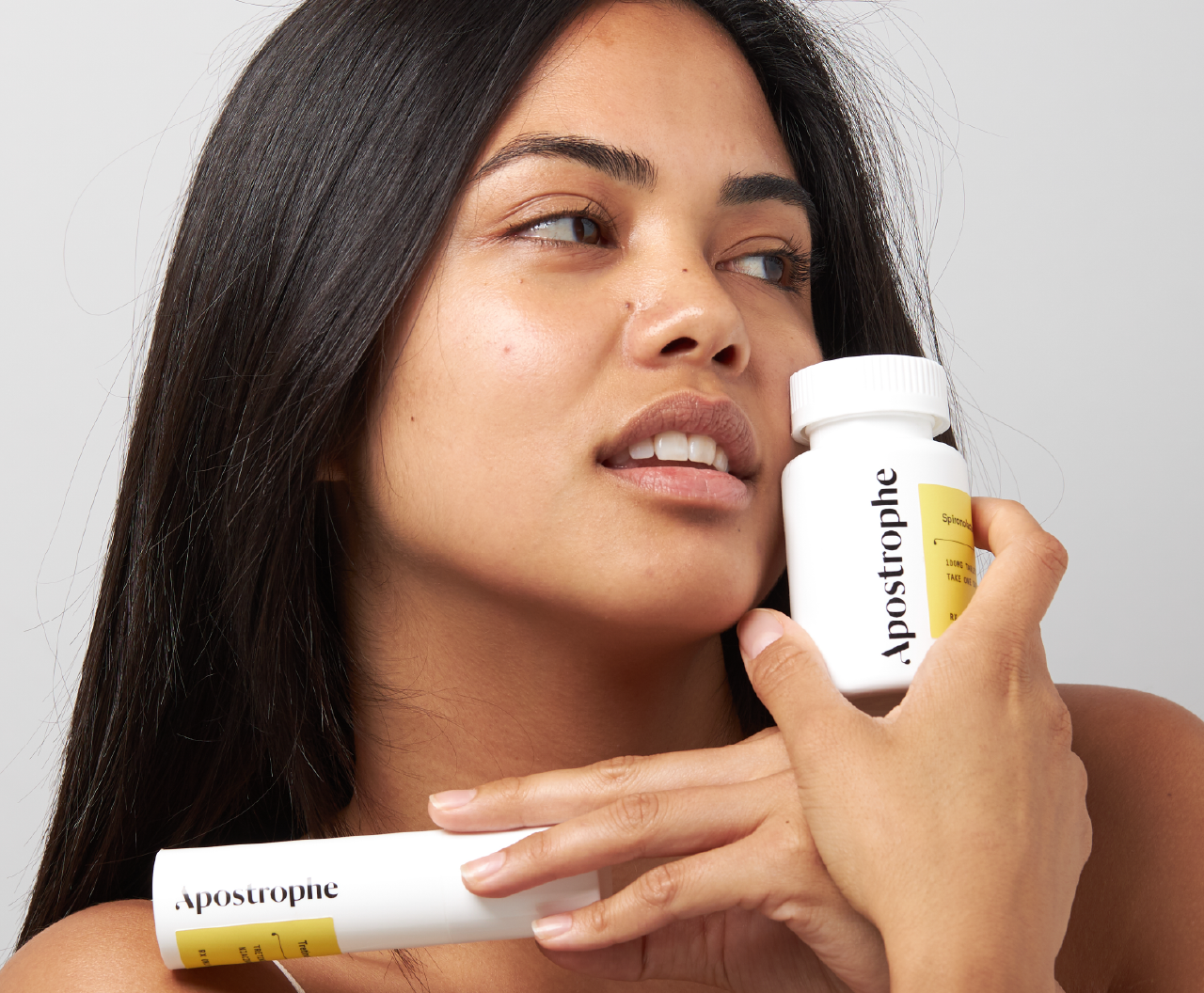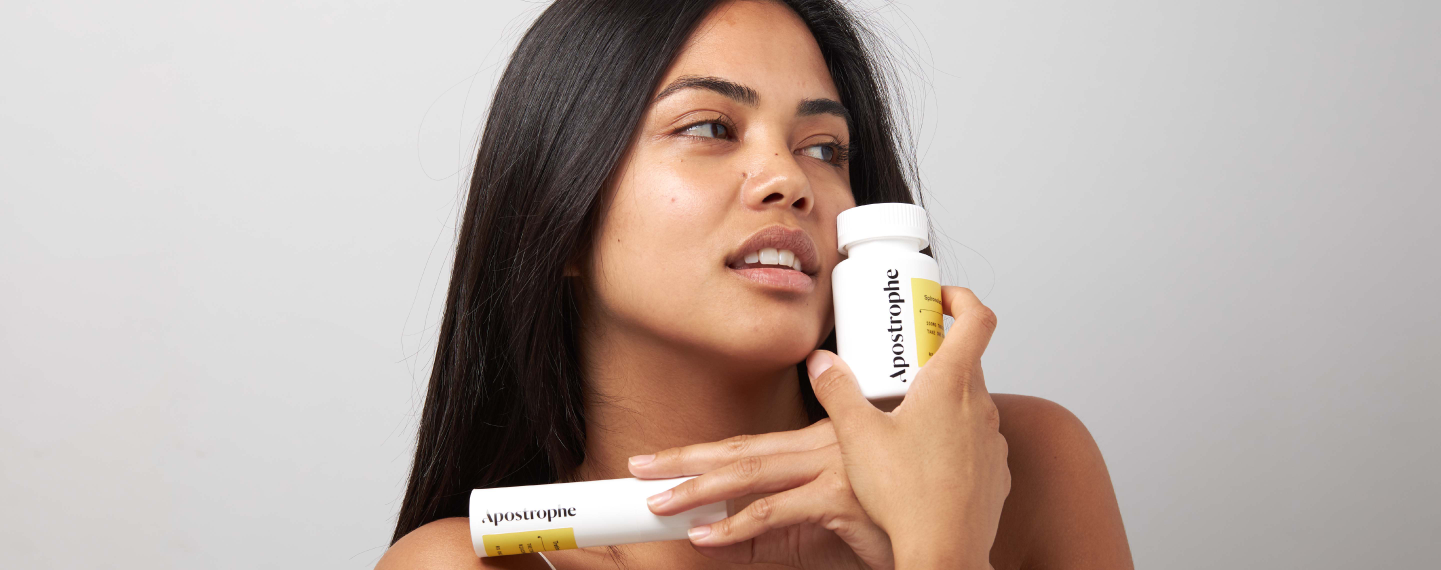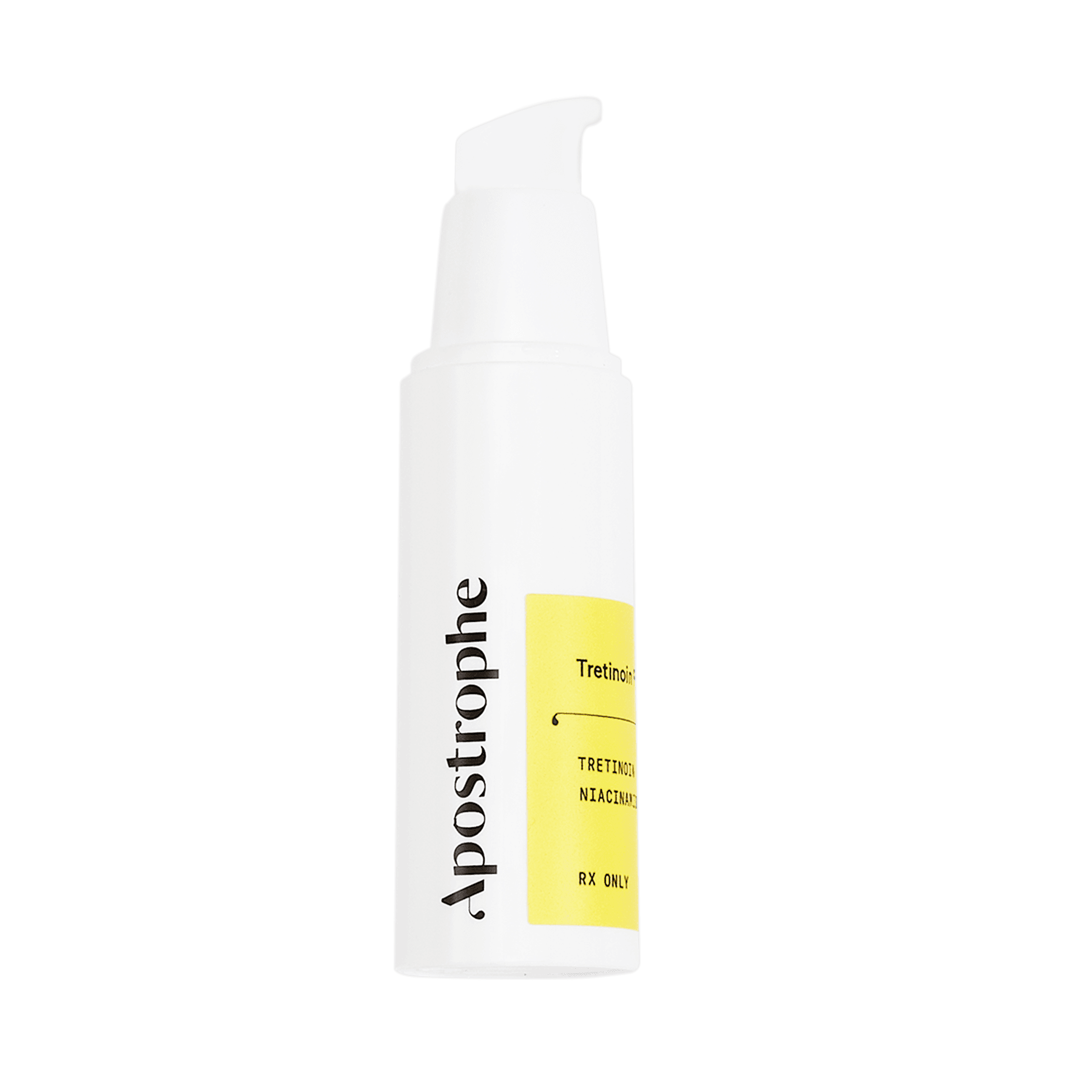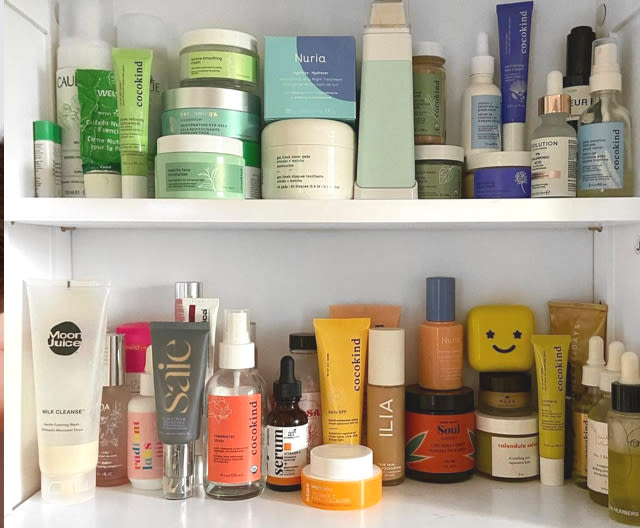Apostrophe Treatments
What is the best acne treatment?


SHARE
Apostrophe Treatments
What is the best acne treatment?
Medically reviewed by Kristin Hall, FNP
Written by Apostrophe Team
Last updated 8/4/2024
Whether you’re prone to small blackheads or serious breakouts of inflamed and painful pimples, dealing with acne is never a fun experience.
Search online for “acne treatments” and you’ll find hundreds of different products, all claiming to offer clear skin. Many of these treatments contain exotic-sounding ingredients and are marketed with big claims about their ability to get rid of pimples and stop breakouts from coming back.
The reality of acne treatments is that while many products may claim to stop acne, only a select few are actually supported by real scientific research.
Below, we’ve explained how and why acne develops, from mild forms of comedonal acne to the deep, painful acne that can pop up during severe breakouts.
We’ve also dug into the science behind popular acne treatments and listed 14 proven products, treatments, and medications that you can use to clear your skin, get rid of acne-causing bacteria, and keep acne breakouts away for good.
Acne Treatments: The Basics
Acne develops when your hair follicles, or pores, become clogged due to a mix of sebum and dead skin cells. When bacteria multiplies inside a clogged hair follicle, it can result in red, inflamed, and painful acne.
While acne treatments are easy to find in drugstores and online, not all products for acne are supported by scientific research.
Since acne can vary in severity, there’s no “best” acne treatment that’s designed to clear acne breakouts for everyone. Instead, a range of different treatments helps to target acne from different angles.
Effective, science-backed ingredients for acne include retinoids, peeling agents, topical or oral antibiotics, and even medications like the combination birth control pill.
If you’re prone to acne and want to get rid of your breakouts for good, your best option is to talk to a licensed healthcare provider about your options.
How Does Acne Develop?
Before we cover the best treatments for acne, it’s important to explain the basics of how pimples and other forms of acne develop in the first place.
Acne breakouts occur when your hair follicles, or pores, become clogged with a combination of sebum and dead skin cells.
Sebum is a natural, oil-like substance that’s secreted by your sebaceous glands. It plays a key role in maintaining your skin by providing it with lubrication and protecting it from bacteria, fungi, and other germs.
Several different factors control your production of sebum, including the levels of certain types of hormones circulating throughout your body.
When your sebaceous glands secrete too much sebum, the excess amount can become stuck inside your hair follicles, causing blockages that can develop into acne lesions.
Another factor in acne breakouts is your body’s production of new skin cells. Over time, as your skin replaces old cells with new ones, the dead, leftover cells can mix with sebum and clog your hair follicles.
These two factors — sebum and dead, leftover skin cells — are responsible for non-inflammatory forms of acne such as whiteheads and blackheads.
A third factor in acne is bacteria. When bacteria is trapped inside a clogged hair follicle, it starts to multiply, causing the acne to become inflamed.
Common forms of inflammatory acne include papules and pustules, which are often referred to as pimples. When inflammatory acne is large, severe, and located deep within your skin, it may be referred to as nodular or nodulocystic acne.
How Acne is Treated
Because acne is caused by a combination of sebum, dead skin cells, and bacteria, the best acne treatments work by targeting one or several of these factors.
For example, some acne treatments work by stopping your sebaceous glands from secreting so much sebum. Others work by stripping away dead skin cells, while others specifically reduce the bacteria that can multiply inside your hair follicles and cause inflamed, painful acne.
Others work behind the scenes by targeting the specific hormonal factors that may contribute to your acne breakouts.
Since several factors all play unique roles in acne, there’s no one-size-fits-all treatment that can get rid of acne breakouts for everyone.
Because of this, it’s important to talk to a healthcare provider if you have acne. You can do this online or by scheduling an appointment with a dermatologist in your area.
They’ll be able to look at your skin and determine the most effective treatment for you based on your skin type, the severity of your acne and other factors.
14 Acne Treatments That Really Work
Below, we’ve listed 14 acne treatments that are supported by real scientific research. Some of these treatments are available over the counter, while others require a prescription.
If you have acne, your healthcare provider may suggest using one or several of the treatments listed below to clear your skin and prevent your breakouts from coming back.
For each treatment, we’ve explained how it works, as well as the results you may experience if you choose it to treat your acne breakouts.
Benzoyl Peroxide
Benzoyl peroxide is a popular ingredient in over-the-counter cleansers, facial washes, and other topical treatments for acne. It works by targeting the bacteria that cause inflamed forms of acne such as papules and pustules.
Since it’s available over the counter, benzoyl peroxide is a good first treatment if you’re prone to inflamed acne.
Although benzoyl peroxide is effective, it can cause side effects such as dry skin and for some people, contact dermatitis. It’s also a mild bleach, meaning you’ll need to be careful if you use it near your hair or fabrics.
To minimize your risk of these side effects, try starting with a mild acne treatment that contains a lower percentage of benzoyl peroxide.
Salicylic Acid
Another over-the-counter ingredient, salicylic acid works by reducing swelling, unblocking your pores, and peeling away the dead skin cells that can cause acne breakouts.
You can find salicylic acid as an active ingredient in many popular cleansers, facial washes, and other over-the-counter acne treatments. Look for products labeled as “spot treatments” and you will often find salicylic acid in the ingredient list.
Like other acne treatments, salicylic acid can cause side effects, including irritation and stinging in areas where it’s applied. If you notice any of these, try using salicylic acid less frequently to give your skin some extra time to recover.
Azelaic Acid
A type of dicarboxylic acid, azelaic acid is used to treat comedonal acne like whiteheads, as well as inflammatory acne like pimples, papules, and cysts.
Azelaic acid also has brightening effects that make it a common choice for treating pigmentation issues that may cause your skin to look blotchy and unevenly colored.
Like salicylic acid, azelaic acid is available over the counter in topical creams, serums, boosters, and other acne and general skin care products. It’s also one of several active ingredients that could be in your Customized Apostrophe Treatment for treating and preventing stubborn acne.
Glycolic Acid
A type of alpha-hydroxy acid (AHA), glycolic acid works by peeling away the outermost layer of your skin, removing acne and other aesthetic issues.
Glycolic acid is a popular ingredient in over-the-counter acne products, as well as peels, toning solutions, and other treatments. It’s also used clinically in peeling procedures for stripping away old skin cells and treating acne, scarring, and pigmentation issues.
Studies of glycolic acid have found that it can get rid of acne, improve skin texture, and give skin a brighter, lighter appearance. However, like other peeling agents, it can cause a range of side effects, including mild skin irritation.
Retinol
Retinoids are medications derived from vitamin A that works by increasing the rate at which your skin creates new cells. They’re popular not just for treating acne, but also for slowing down the effects of aging on your skin.
Several over-the-counter and prescription retinoids are available. A particularly common one is retinol — a mild, over-the-counter ingredient that you can find in lots of acne serums, cleansers, creams, and other products.
While retinol isn’t as strong as prescription retinoids (a topic we’ve covered below), it’s an option worth considering if you have mild acne and want a safe, science-backed treatment that can stop breakouts from coming back.
Adapalene
Adapalene is a more powerful retinoid that’s used for treating acne, slowing the effects of aging and treating other skin issues. It works by stopping pimples from forming below the upper layer of your skin.
If you’ve tried retinol and want something that’s stronger but still available without a prescription, adapalene is a good choice.
Research shows that adapalene is effective at treating and preventing acne. In an analysis from 1998, researchers found that a gel containing 0.1% adapalene was as effective at treating acne as tretinoin, a popular prescription retinoid.
Until recently, Adapalene was only available with a prescription. Today, mild adapalene products such as Differin® and many other creams, gels, and treatments are available over the counter in most local drugstores and online.
Tretinoin
Tretinoin is a prescription retinoid that’s used for anti-aging and as an acne treatment. You may have heard of it before under the brand name Retin-A. It’s available as a cream, gel, and as an active ingredient in acne treatments like Apostrophe Tretinoin formula.

PRESCRIPTION TRETINOIN
Target acne, dark spots, and signs of aging with this science-backed ingredient.
As a topical retinoid, tretinoin works by unclogging your pores and encouraging the shedding of old, dead skin cells.
Tretinoin has been around for decades and has a reputation as one of the most effective acne treatments available. Numerous large-scale studies have shown that it’s effective at getting rid of everything from whiteheads and blackheads to inflammatory acne.
As a bonus, tretinoin is also highly effective at treating wrinkles, discoloration, and several other common signs of aging.
If you’ve tried milder retinoids like retinol and adapalene without much in the way of results, you may want to talk to a healthcare provider about using tretinoin.
Like many other acne treatments, tretinoin isn’t totally free of side effects. Common side effects include dryness, irritation, and peeling. Most of these go away during the first few months, but some may be persistent.
You can learn more about how tretinoin works as an acne treatment, its side effects, and more in our full guide to treating acne with tretinoin.
Clindamycin
Clindamycin is a topical antibiotic. It works by reducing swelling and stopping or slowing down the bacteria that cause inflammatory acne from multiplying on your skin and inside your hair follicles.
Your healthcare provider may prescribe clindamycin if you have infected acne such as pustules, papules, or nodulocystic acne lesions. It’s sometimes used in combination with benzoyl peroxide to target acne-causing bacteria from multiple angles.
Clindamycin is one of several ingredients that could be in your Custom Apostrophe Treatment, which is designed specifically to treat your unique skin concerns.
Like other topical acne treatments, topical clindamycin may cause dryness, itching, peeling, and other side effects. You can learn more about these side effects, as well as clindamycin’s effects on acne, in our full guide to clindamycin as an acne treatment.
Topical Dapsone
Dapsone is a topical antibiotic that’s used to treat acne in children, teens and adults. Like other antibiotics, it works by slowing down or preventing acne-causing bacteria from growing on your skin and inside your pores.
Dapsone is sold as Aczone® and under several other brand names. It may take up to 12 weeks before you notice improvements in your skin after starting this medication.
Oral Antibiotics
If you have unusually severe or persistent inflammatory acne that doesn’t seem to go away with other treatments, your healthcare provider may prescribe oral antibiotics.
Like topical antibiotics, these work by preventing acne-causing bacteria from multiplying on your skin and inside your hair follicles.
Popular oral antibiotics for acne include doxycycline, minocycline, tetracycline, erythromycin, and others. You may need to take these at the same time as you use a topical acne medication like retinoids or benzoyl peroxide to keep acne under control long term.
Oral antibiotics are effective, but they have downsides. One of these is that your acne breakouts might come back after you finish treatment. Another is that some oral antibiotics may harm good bacteria that grow in your body, increasing your risk of issues like yeast infections.
Isotretinoin
Isotretinoin is an oral prescription medication that’s used to treat severe acne, particularly acne that doesn’t respond to other medications. It used to be sold as Accutane®.
If you have severe, persistent acne that just never seems to go away, your healthcare provider might prescribe this medication.
Isotretinoin works by reducing sebum production, which may help to prevent your hair follicles from becoming clogged. Most people need to take isotretinoin for four to five months to clear their skin and stop acne breakouts from coming back.
While isotretinoin is highly effective at treating acne, it can cause side effects and is not safe for use during pregnancy.
Common side effects of isotretinoin include dry skin, dry mouth, dry nose, and extra sensitivity to sunlight. A particularly common side effect is dry lips, which affects about 90 percent of people who use isotretinoin for acne.
Because of isotretinoin’s side effects and risks during pregnancy, you’ll need to complete some paperwork and take certain precautions in order to use this medication.
First, you’ll need to sign an informed consent sheet with your dermatologist before you start to use isotretinoin. Second, since isotretinoin can cause severe birth defects, you’ll need to use multiple forms of birth control for the entire treatment period.
Finally, you’ll need to keep in regular contact with your healthcare provider to check that you’re okay, including monthly office visits and regular pregnancy tests.
The Birth Control Pill
Believe it or not, one of the most effective treatments available for acne is the combination birth control pill.
Birth control treats acne at a hormonal level by reducing your body’s production of the androgen hormones that stimulate sebum production. This makes your skin less oily, reducing your risk of developing clogged pores and acne lesions.
Not all birth control pills treat acne. Currently, the FDA has approved three pills — Yaz®, Estrostep® and Ortho Tri-Cycle®n — as acne medications. These are combination pills, meaning they contain ethinyl estradiol (a type of estrogen) and a progestin hormone.
If you’d like to start using birth control to treat acne, you can talk to a healthcare provider to learn more about your options.
Spironolactone
Spironolactone is a prescription medication that’s used for several health conditions, including hormone imbalances, high blood pressure, and heart failure.
It’s also used off-label as a treatment for certain types of acne. Spironolactone works by lowering your levels of male sex hormones that stimulate sebum production. This can help to get rid of acne, especially in areas such as your jawline, neck, and lower face.
Because of spironolactone’s effects on hormone production, this medication isn’t safe for use in men. It’s also unsafe to use this medication if you’re pregnant or planning to become pregnant in the near future.
To keep yourself safe, your healthcare provider will generally recommend using the birth control pill at the same time as spironolactone. Since the pill also helps to treat acne, this may improve your results and make your efforts against acne more effective.
Our detailed guide to spironolactone explains more about spironolactone’s benefits as an acne treatment, potential side effects, and more.
Corticosteroids
If you have seriously inflamed or painful acne and visit your dermatologist in person, they may use corticosteroids like cortisone as a quick treatment.
These medications work by reducing inflammation. When applied to acne, they can make large, inflamed cysts and nodules become smaller and less painful.
Other corticosteroids, such as prednisone, are also used to treat severe forms of acne, such as acne fulminans.
Corticosteroids are highly effective, but they can cause side effects when overused. Because of this, your dermatologist will only use these medications when needed.
In Conclusion
Dealing with acne can be a frustrating experience. Luckily, almost all acne can be treated with the right approach.
While there’s no one-size-fits-all “best” treatment for acne, a variety of different medications and products can help to bring your breakouts under control and clear your skin.
If you have acne, it’s important to talk to a licensed healthcare provider to learn more about your treatment options. They’ll be able to recommend one or several safe, science-backed ingredients to stop your acne breakouts and keep your skin clear over the long term.
*A note on benzoyl peroxide. In March 2024, Valisure shared results of a study that showcased that benzene can form in benzoyl peroxide (BPO) products. We currently recommend avoiding benzoyl peroxide products until the FDA provides more guidance on the safety of BPO.
References
Hoover, E., Aslam, S. & Krishnamurthy, K. (2020, October 26). Physiology, Sebaceous Glands. StatPearls. Retrieved from https://www.ncbi.nlm.nih.gov/books/NBK499819/ |
Overview of Acne. (2020, August). Retrieved from https://www.niams.nih.gov/health-topics/acne/advanced |
Acne. (n.d.). Retrieved from https://www.americanskin.org/resource/acne.php |
Matin, T. & Goodman, M.B. (2020, November 24). Benzoyl Peroxide. StatPearls. Retrieved from https://www.ncbi.nlm.nih.gov/books/NBK537220/ |
Salicylic Acid Topical. (2016, September 15). Retrieved from https://medlineplus.gov/druginfo/meds/a607072.html |
Fitton, A. & Goa, K.L. (1991, May). Azelaic acid. A review of its pharmacological properties and therapeutic efficacy in acne and hyperpigmentary skin disorders. Drugs. 41 (5), 780-98. Retrieved from https://pubmed.ncbi.nlm.nih.gov/1712709/ |
Davis, E.C. & Callender, V.D. (2010, July). Postinflammatory Hyperpigmentation. Journal of Clinical and Aesthetic Dermatology. 3 (7), 20–31. Retrieved from https://www.ncbi.nlm.nih.gov/pmc/articles/PMC2921758/ |
Tang, S.C. & Yang, J.H. (2018, April). Dual Effects of Alpha-Hydroxy Acids on the Skin. Molecules. 23 (4), 863. Retrieved from https://www.ncbi.nlm.nih.gov/pmc/articles/PMC6017965/ |
Sharad, J. (2013). Glycolic acid peel therapy – a current review. Clinical, Cosmetic and Investigational Dermatology. 6, 281–288. Retrieved from https://www.ncbi.nlm.nih.gov/pmc/articles/PMC3875240/ |
Mukherjee, S., et al. (2006, December). Retinoids in the treatment of skin aging: an overview of clinical efficacy and safety. Clinical Interventions in Aging. 1 (4), 327–348. Retrieved from https://www.ncbi.nlm.nih.gov/pmc/articles/PMC2699641/ |
Adapalene. (2016, September 15). Retrieved from https://medlineplus.gov/druginfo/meds/a604001.html |
Cunliffe, W.J., Poncet, M., Loesche, C. & Verschoore, M. (1998, October). A comparison of the efficacy and tolerability of adapalene 0.1% gel versus tretinoin 0.025% gel in patients with acne vulgaris: a meta-analysis of five randomized trials. British Journal of Dermatology. 139 Suppl 52, 48-56. Retrieved from https://pubmed.ncbi.nlm.nih.gov/9990421/ |
Tretinoin Topical. (2019, March 15). Retrieved from https://medlineplus.gov/druginfo/meds/a682437.html |
Leyden, J., Stein-Gold, L. & Weiss, J. (2017, September). Why Topical Retinoids Are Mainstay of Therapy for Acne. Dermatology and Therapy. 7 (3), 293–304. Retrieved from https://www.ncbi.nlm.nih.gov/pmc/articles/PMC5574737/ |
Clindamycin Topical. (2016, October 15). Retrieved from https://medlineplus.gov/druginfo/meds/a609005.html |
Clindamycin and Benzoyl Peroxide Topical. (2016, March 15). Retrieved from https://medlineplus.gov/druginfo/meds/a603021.html |
Dapsone Topical. (2019, November 15). Retrieved from https://medlineplus.gov/druginfo/meds/a616045.html |
Leyden, J.J. & Del Rosso, J.Q. (2011, February). Oral Antibiotic Therapy for Acne Vulgaris. Journal of Clinical and Aesthetic Dermatology. 4 (2), 40–47. Retrieved from https://www.ncbi.nlm.nih.gov/pmc/articles/PMC3050614/ |
Vaginal yeast infections. (2019, April 1). Retrieved from https://www.womenshealth.gov/a-z-topics/vaginal-yeast-infections |
Isotretinoin. (2018, August 15). Retrieved from https://medlineplus.gov/druginfo/meds/a681043.html |
Pile, H.D. & Sadiq, N.M. (2020, May 16). Isotretinoin. StatPearls. Retrieved from https://www.ncbi.nlm.nih.gov/books/NBK525949/ |
Stubborn Acne? Hormonal Therapy May Help. (n.d.). Retrieved from https://www.aad.org/public/diseases/acne/derm-treat/hormonal-therapy |
What Can Clear Severe Acne? (n.d.). Retrieved from https://www.aad.org/public/diseases/acne/derm-treat/severe-acne |
Trivedi, M. K., Shinkai, K., & Murase, J. E. (2017). A Review of hormone-based therapies to treat adult acne vulgaris in women. International journal of womens dermatology, 3(1), 44–52. https://www.ncbi.nlm.nih.gov/pmc/articles/PMC5419026/
Shop this post

Tretinoin

Clindamycin
Like what you just read? Sign up for our email list to get the scoop on skincare science delivered straight to your inbox.

Education
What is milia?
What is milia? Today, we’re jumping into one type of bump that you may have heard about most commonly in infants — milia.
Read More
Education
Best moisturizer for acne-prone skin
If you have combination acne-prone skin, figuring out which moisturizer is best for your skin might be tough. In this guide, we break down the best moisturizer for combination, acne-prone skin.
Read More
Education
How to build a face care routine
As you get into skincare, it might seem overwhelming, especially trying to figure out the order you're supposed to apply products in. Below, we detail how to build a face care routine for your skin!
Read More
